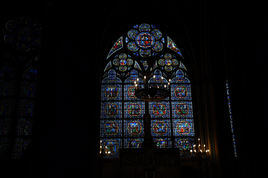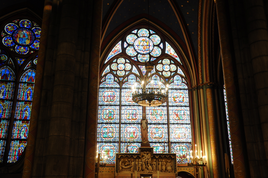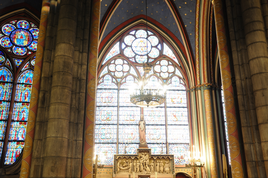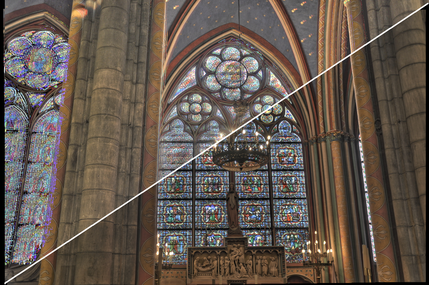
Welcome to the homepage of the lecture
Advanced Image Analysis
Winter Term 2017
Home
About Us
People
Teaching
Research
Publications
Awards
Links
Contact
Internal
Advanced Image Analysis
Lecturer:
Dr. Pascal Peter
Winter Term 2017
Lecture (2h) with exercises (2h)
6 credit points
Lectures: Thursday 16-18 c.t., Building E1.3, Lecture Hall 003
First lecture: Thursday, Oct 19, 2017
Tutor:
Kireeti Bodduna
Office Hour: Tuesday, 4-5 pm
Tutorials:
Monday 16-18 c.t.
Building E1.3, Seminar Room 016 (theory)
Building E1.3, CIP 104 (programming)
First tutorial: Monday, Oct 30, 2017
Announcements –
Description –
Entrance requirements –
Contents
Exams –
Lecture notes/Assignments –
References
04/04/2018
You can find your result of the second exam here.
General statistics about this exam can be downloaded here.
Each student who has participated in the second written exam has the
opportunity to inspect his/her graded solutions in room 4.10 in Bldg. E1.7 on
Friday, April 6th, 2018, 11:30 am - 12:00 pm
27/10/2017 Registration is now closed.
18/10/2017 Website is online
Registration for this lecture was open until Thursday, Oct 26. Keep in mind that in most courses of studies, you also have to register via the HISPOS system of the Saarland University
In this lecture, we will discuss advanced topics in the fields of image processing
and computer vision. Most of the presented methods fuse the information from several
images in order to produce an enhanced composite image. Examples for such techniques
are super-resolution, high dynamic range (HDR) imaging, tone mapping and
gradient domain techniques.
Example: Freehand High Dynamic Range Imaging



|

|
| Exposure series | Tone mapped HDR reconstruction without and with alignment |
Requires undergraduate knowledge in mathematics (e.g. ''Mathematik für Informatiker I-III''), and elementary C knowledge. Basic knowledge in image processing and computer vision is recommendable. The lectures and tutorials will be given in English.
In order to qualify for the exams, attendance of the tutorials is mandatory.
You will not be allowed to take part in the exams if you miss more than two tutorials.
In case of qualification, you are allowed to take part in both exams. The final grade
will be the best grade out of the two exams.
There will be two closed book written exams:
The first written exam will take place on Friday, February 2, 2018
from 2:00 to 4:00 pm in Building E1.3, Lecture Hall 002.
The second written exam will take place on Tuesday, April 3, 2018
from 2:00 to 4:00 pm in Building E1.3, Lecture Hall 002.
These are closed book exams.
You can participate in both exams, and the better grades counts.
Please remember that you have to register online for the exam
in the HISPOS system of the Saarland University.
If you cannot attend the exam, contact Pascal Peter as early as possible.
In case you have proof that you cannot take part for medical reasons or you
have another exam on the same day, we can offer you an oral exam as a replacement.
Note that we need written proof (e.g. a certificate from a physician/Krankenschein)
for the exact date of the exam.
These are the rules during the exams:
- No lecture materials are admitted during the exam.
- Pocket calculators are not allowed.
- Mobile phones, PDAs, laptops, smart watches, and other electronic devices have to be turned off.
- Please keep your student ID card ready for an attendance check during the exam.
- Do not write solutions with pencils or friction pens.
- You are not allowed to take the exam sheets with you.
- You must stay until the exam is completely over.
Participants can download course materials
(lecture notes, assignments) here. For all assignments, example solutions
will be provided. Additional organisational information, examples and explanations
that may be relevant for your understanding and the exam are provided
in the lectures and tutorials. It is solely your responsibility
- not ours - to make sure that you receive this infomation.
The table below contains the planned topics for the lecture.
The slides are available in two versions: the "script" version is printer friendly
while the "slide" version retains the functionality to enlarge images and use slide navigation.
| No. | Title | Date | Script | Slides |
| 1 | Introduction and Overview | 19/10 | [download] | [download] [high quality] |
| 2 | Finding Correspondences | 26/10 | [download] | [download] |
| 3 | Super-Resolution | 02/11 | [download] | [download] |
| 4 | High Dynamic Range Imaging | 09/11 | [download] | [download] |
| 5 | Tone Mapping I: Global and Local Operators | 16/11 | [download] | [download] |
| 6 | Tone Mapping II: Frequency and Gradient Domain Operators | 23/11 | [download] | [download] |
| 7 | Exposure Fusion | 30/11 | [download] | [download] |
| 8 | Alignment of Exposure Series I: Global Motion | 07/12 | [download] | [download] |
| 9 | Alignment of Exposure Series II: Local Motion | 14/12 | [download] | [download] |
| 10 | Deghosting and Joint Super-Resolution and HDR | 21/12 | [download] | [download] |
| 11 | Focus Stacking | 04/01 | [download] | [download] |
| 12 | Gradient Domain Techniques I: Basics | 11/01 | [download] | [download] |
| 13 | Gradient Domain Techniques II: Applications | 18/01 | [download] | [download] |
| 14 | Summary and Outlook | 25/01 | [download] | [download] |
Each week we have either a theory or a programming tutorial. They take place in:
Monday 16-18 c.t.
Building E1.3, Seminar Room 016 (theory)
Building E1.3, CIP 104 (programming)
Programming excercises and theoretical assignments are offered as part of the tutorials. The regular attendance of these tutorials is required for the admission to the exam. You will not be allowed to take part in the exam if you miss more than two tutorials.
The assignments and the source code needed for the programming assignments will be
provided here during the semester.
| No. | Assignments | Date | Solutions |
| 1 | Tutorial 1: Correspondence Problems (theory) | 30/10 | Solution 1 |
| 2 |
Tutorial 2: Correspondence Problems (programming) Sources |
06/11 | Solution 2 |
| 3 | Tutorial 3: Superresolution (theory) | 13/11 | Solution 3 |
| 4 |
Tutorial 4: Superresolution (programming) Sources |
20/11 | Solution 4 |
| 5 | Tutorial 5: HDR/Tone Mapping (theory) | 27/11 | Solution 5 |
| 6 |
Tutorial 6: HDR/Tone Mapping (programming) Sources |
04/12 | Solution 6 |
| 7 | Tutorial 7: Exposure Fusion (theory) | 11/12 | Solution 7 |
| 8 |
Tutorial 8: Exposure Fusion (programming) Sources |
18/12 | Solution 8 |
| 9 |
Tutorial 9: Homographies (theory) Due to a holiday, this tutorial has been moved to 02/01, 16-18, E1.3, SR16. |
02/01 | Solution 9 |
| 10 |
Tutorial 10: Depth from Focus (programming) Sources |
08/01 | Solution 10 |
| 11 | Tutorial 11: Poisson Equations (theory) | 15/01 | Solution 11 |
| 12 |
Tutorial 12: Image Cloning (programming) Sources |
22/01 | Solution 12 |
| 13 | Tutorial 13: Test Exam. | 29/01 | Solution |
There is no specific book that covers the complete content of this class.
Many lectures will be based on articles from journals and conferences.
However, the recent book of R. Szeliski covers some of the topics and
additionally summarises most of the intensively studied areas of computer
vision research:
R. Szeliski: Computer Vision: Algorithms and Applications.
ISBN: 978-1-84882-934-3, Springer, Berlin, 2011.
Note: You can download a PDF version of the book here.
MIA Group
©2001-2023
The author is not
responsible for
the content of
external pages.
Imprint -
Data protection